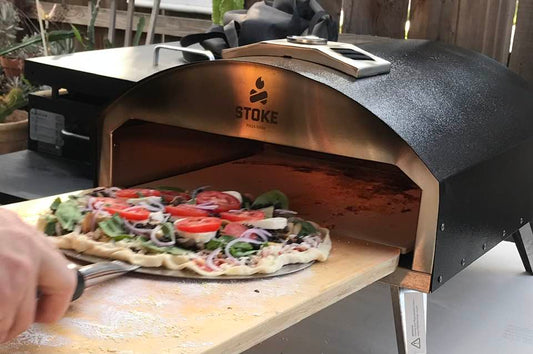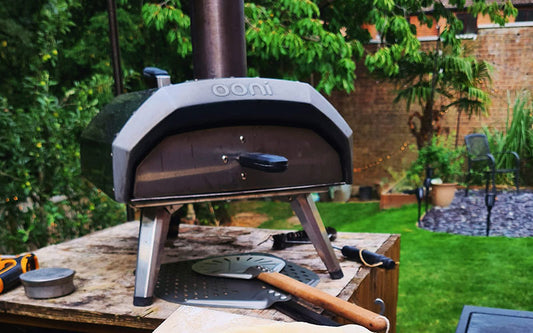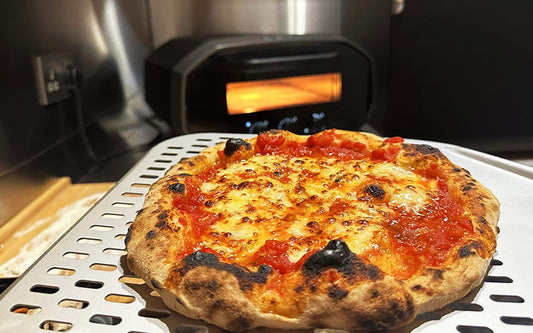The pizza dough windowpane test is like a secret handshake for pizza chefs. If your dough passes the test, you’re in the club. And trust me, you want to be in this club!
The windowpane test is a crucial step that you don’t want to skip. It involves stretching a small piece of dough thin enough to see through, without it tearing or breaking. It’s a surefire way to tell if your pizza dough has developed the right amount of gluten.
The gluten strands are responsible for holding the dough together and creating the desired texture and structure. So, how do you make your pizza dough clear the windowpane test? And is there a cheat code for this test?
Let’s find out:
💭 What Exactly Is a Dough Windowpane Test?
The windowpane test is a critical step in developing gluten. The name comes from the fact that the stretched dough resembles a thin, translucent membrane, just like a… you’re right, a windowpane.
So, just like you can see through a real windowpane, you can see through the stretched pizza dough when it passes the windowpane test. It’s a visual cue that tells you that the dough has the perfect gluten formation and is ready for shaping into a perfect pizza crust.
The dough clears this test only when the dough has developed enough to create a strong, stretchy network of protein strands. A strong gluten network equals a crust you can be proud of.
If the dough tears or breaks apart when you stretch it between your fingers, it implies underdeveloped gluten. And if the dough stretches too much without breaking, it probably means it’s overworked.
🍕So, What Is the Ideal Pizza Dough Consistency for Windowpane Effect?
The ideal consistency of the pizza dough for the window pane test is smooth and elastic. When you touch the dough, it should feel soft and pliable, with a slightly tacky texture. If the dough feels too sticky or too stiff, it may not pass the windowpane test.
Remember, it may take a few tries to get the hang of the windowpane test. Don’t worry if your first attempt is not successful. Just keep practicing, and you’ll soon be able to recognize the perfect dough consistency and pass the windowpane test with ease. I promise!
🤔 How to Perform the Pizza Dough Windowpane Test?
Sob story…
I remember when I first started making pizza dough. I had no idea what the windowpane test was, and I didn’t understand how important it was. I used to knead the dough until I got tired. Because why not? But boy, was I wrong! My pizzas turned out to be terrible, and I couldn’t figure out why.
It wasn’t until I attended a pizza-making workshop that I learned about the windowpane test. I was amazed at how such a simple test could make such an incredible difference in the final product. It took some practice, but once I got the hang of it, my pizza crusts ceased to suck.
Now, let me walk you through how to perform the windowpane test:
- Take a small piece of dough, about the size of a golf ball, and flatten it into a disc. Then, hold the dough up to the light and gently stretch it from the edges, rotating it as you go.
- You want to stretch it until it’s so thin that you can see light through it. Be gentle while stretching, though. If the dough rips apart, it means you need to knead it a bit longer. And if it stretches too much without breaking, stop kneading and let it rest.
🎭 Troubleshooting Common Issues That Prevent the Windowpane Effect
You Are Rushing It
A common mistake that a lot of people make, including the old me, is not giving the dough enough time to rest before attempting the windowpane test. Gluten needs time to relax and settle after kneading. So make sure to let the dough rest for at least 30 minutes before testing it.
Wrong Choice of Flour
Different types of flour have different levels of protein, which affects the gluten development in your dough. If you’re using a low-protein flour like AP flour or cake flour, you won’t be able to achieve a strong enough gluten structure, and your dough won’t pass the windowpane test, unless you really know what you’re doing.
00 flour with around 12-13% gluten is what I’d recommend. You can also use a combination of bread flour and pizza flour. Bread flour usually has a higher gluten content, which makes the dough easier to stretch with tearing.
You can use bread flour to make pizza if you prefer a bread-like crust over a thin, light, and airy crust.
The crux of the matter is, if you’re using a new type of flour, adjust the resting and kneading time accordingly. This could take a couple of trials and errors to get right.
Excess Flour
Initially, I also used to make the cardinal mistake of adding too much flour to my pizza dough, which would make it too dry and crumbly. When the dough is dry, it becomes difficult to stretch and shape, and it won’t clear the windowpane test. So, be careful not to add too much flour to your dough.
Not Kneading Enough
How long and how intensely you knead the dough is going to have a huge impact on the finishing product. If you don’t knead it long enough, the gluten won’t develop properly. And you won’t be able to crack the windowpane test.
So, make sure you knead the dough thoroughly for at least 10-12 minutes by hand. If you are using a stand mixer, 4-6 minutes should be enough. That said, some recipes call for a shorter kneading time by hand. So just follow the recipe to the tee if you are a beginner.
Over-hydrated Dough
Adding too much water to your pizza dough will naturally make it too sticky and wet, thus preventing it from passing the windowpane test. Again, do keep in mind that different flours have different water absorption capacities. The hydration level will also depend on what kind of crust you’re going after and the fermentation period.
The solution? Read the recipe carefully. Measure your ingredients carefully, and add water gradually. If you are new to this, I would suggest sticking to a 60-65% hydration recipe. Go for higher hydration doughs once you gain some experience with making pizza doughs from scratch.
🤫Top Secret Tip to Help Your Dough Pass the Windowpane Test! (If the Regular Method Isn’t Working)
Pizza dough won’t pass the windowpane test despite your sincere efforts? Try this trick the next time to ratchet up the gluten development:
The Autolyse Method: Autolysing is another way to develop the gluten in a dough. This technique can help you develop gluten without having to knead as much. This method requires you to mix all the ingredients and rest it for 15-30 minutes before kneading.
During this time, the gluten will have a chance to fully hydrate. This is necessary for it to start developing. This will also give the amylase enzymes enough time to turn starch into sugars and give the yeast a head start.
With the autolyse method, you’ll be able to reduce your kneading time, while still developing a gluten network strong enough to pass the windowpane test with flying colors.
🙋Why Is Windowpane Test Important for Pizza Doughs? Role of Gluten
The role of gluten cannot be overstated when it comes to pizza dough. Gluten is a protein found in wheat flour that gives pizza dough its elasticity and chewiness.
By performing the windowpane test, you can assess whether your dough has developed enough gluten to give it the desired texture and structure.
The main purpose of pizza dough windowpane test is to accurately gauge the gluten strength/maturity of the dough. Gluten strength determines the texture of the crust.
If the dough can be stretched thin enough without tearing, it means you have nailed the dough. And if it doesn’t, don’t despair and knead it some more. Make sure to give the dough 15 minutes to relax before kneading again.
But the benefits of the windowpane test go beyond just achieving the perfect texture. It can also help you ensure that your crust will cook evenly and hold its shape during baking. A well-developed gluten network will help your crust rise evenly and hold up under the weight of your toppings.
❔Can I Bake Pizza Dough Even if It Doesn’t Pass the Windowpane Test?
As I’ve already discussed, gluten is what gives pizza dough its structure and chewy texture. Without it, your pizza crust will be flat and lifeless. If your dough doesn’t clear the windowpane test, you may end up with a dough that’s either underdeveloped or overworked.
This could result in a tough, dense crust that nobody wants to eat. You can still bake it, though. But be mentally prepared for a flat, crumbly, cracker-like dough.
In Conclusion
Perfecting the pizza dough windowpane test takes practice and patience. But with time and practice, you’ll become more confident in your ability to read your dough and adjust your technique accordingly. And trust me, once you start using the windowpane test in your pizza-making routine, you’ll wonder how you ever made pizza without it.
So, next time you’re making pizza dough, don’t skip the windowpane test.




